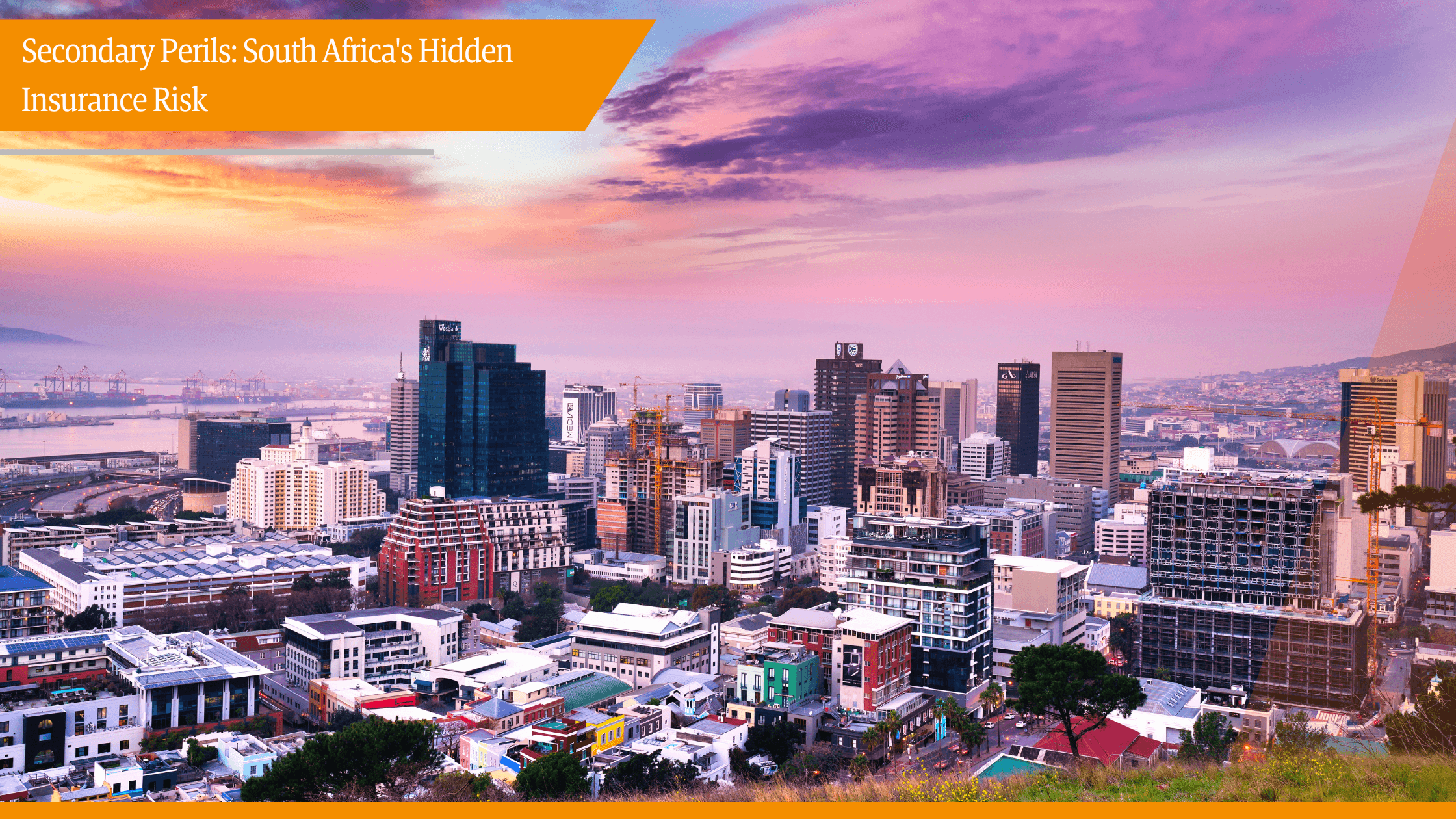Large Commercial and Corporate property insurance has always contended with catastrophic events such as widespread storms, major fires, significant natural disasters, which are less frequent but result in widespread and very extensive damage and are mainly weather-related. These are also sometimes called Primary perils. In recent years however, insurers and reinsurers have fundamentally shifted focus to what the industry terms secondary perils.
These smaller, more frequent but less severe events such as hailstorms, flash floods, fire spread and social unrest may appear limited individually, but collectively drive a substantial portion of insured losses across South Africa. After more than two decades in large commercial and corporate property underwriting, I’ve watched these exposures transform from minor considerations to primary drivers of underwriting decisions.
The implications extend far beyond premium adjustments. Secondary perils are reshaping how we evaluate risk, structure coverage, and advise clients. For brokers, understanding these exposures and presenting them credibly to insurers has evolved from helpful knowledge to strategic necessity.
Defining Secondary Perils in Context
Primary perils are the headline events: earthquakes, hurricanes, major cyclones that dominate news cycles and trigger widespread industry response. Secondary perils operate differently as they are more localised, occurring with higher frequency that rarely attract international attention but consistently drain insurers’ balance sheets.
In South Africa, these exposures have become painfully familiar:
- Hailstorms systematically damage roofs, stock, and vehicle fleets across Gauteng’s industrial corridors.
- Flash floods, especially in KwaZulu-Natal, repeatedly affected warehouses, port facilities, and logistics hubs with increasing severity.
- Fire spread from informal settlement encroachment into adjacent commercial and industrial properties.
- Social unrest, exemplified by the July 2021 riots, causing widespread damage to shopping centres, distribution facilities, and manufacturing sites.
Global reinsurers have taken notice. Munich Re specifically warns that Secondary perils now represent key drivers of insured losses worldwide, fundamentally altering industry risk assessment methodologies. This international recognition validates what many South African underwriters have observed locally: These perils demand serious attention.
The Growing Focus on Secondary Perils
Several converging factors explain why these exposures attract increasing scrutiny from capacity providers:
Relentless frequency – Unlike generational catastrophes, Secondary perils occur annually across multiple regions, creating predictable drain on insurer reserves.
Accelerating urbanisation – South Africa’s expanding commercial footprint increases exposure concentration, particularly where infrastructure development lags behind economic growth.
Climate unpredictability – Irregular rainfall patterns and extreme weather events intensify flood and hail risks beyond historical modelling parameters.
Socio-economic pressures – Economic inequality and social tensions create exposures that extend well beyond traditional natural hazard categories.
Infrastructure limitations – Ageing municipal infrastructure struggles to cope with extreme weather events, amplifying damage potential.
Marsh research confirms that secondary perils now materially influence how insurers model risk and allocate capacity across portfolios. This shift manifests clearly in local markets, where underwriters routinely apply higher deductibles or specific exclusions unless clients demonstrate credible mitigation strategies.
Industry commentary has reinforced this point. As reported in FA News, secondary perils are no longer peripheral issues but pivotal factors in the global risk environment. Their growing frequency and severity in South Africa not only threaten economic stability but also contribute to higher premiums, larger deductibles and concerns that certain high-risk areas may become uninsurable. Encouragingly, some insurers are advancing their risk models by incorporating Geographic Information Systems, enabling more accurate location-based assessments of property exposures.
From an underwriting perspective, I’ve seen this evolution accelerate dramatically since 2020. Risks that previously received standard terms now require detailed exposure analysis and mitigation evidence before capacity providers will commit.
Critical Implications for Broker Strategy
While systemic risks remain beyond individual business control, they directly determine commercial property insurance outcomes. The broker’s role involves bridging the gap between macro-environmental pressures and client-level resilience planning.
This responsibility encompasses several critical areas:
Comprehensive valuations – Ensuring sums insured accurately reflect realistic exposure to hail damage, water ingress, or fire spread scenarios. Undervaluation proves particularly costly where average clauses apply, as I’ve witnessed in numerous post-loss adjustments.
Robust mitigation documentation – Presenting verifiable records of firebreak maintenance, roof reinforcement programmes, drainage capacity upgrades, or comprehensive contingency planning for social unrest scenarios.
Proactive client education – Explaining premium adjustments or coverage restrictions based on demonstrable Secondary peril exposure, while guiding clients toward practical, cost-effective improvements.
Informed placement strategy – Identifying insurers with genuine appetite for specific exposures and negotiating based on credible data analysis rather than market assumptions or historical precedent.
In my regular discussions with broker partners, I emphasise that insurers seek evidence of awareness and proactive management, not perfect risk elimination. A commercial property adjacent to informal settlements or located in flood-prone areas may remain insurable, but requires brokers to present mitigation measures clearly and professionally.
The distinction matters significantly. Properties with documented risk management protocols receive markedly different terms compared to those where exposure appears unmanaged or ignored.
Case Study: KwaZulu-Natal Flood Impact
The 2022 KwaZulu-Natal floods provide a sobering illustration of secondary peril impact. News24 reported billions of rand in damage affecting factories, port operations, and retail assets across the province. While the event itself qualified as a major flood disaster, the losses reflected cumulative impact of smaller, addressable vulnerabilities.
These included inadequate drainage systems, poorly maintained stormwater infrastructure, and limited business continuity planning. Properties with comprehensive flood mitigation plans like proper drainage, elevated storage and emergency protocols, experienced significantly reduced losses compared to unprepared neighbours.
The event taught the industry that insurers now examine not only physical assets but also operational environments surrounding them. Evidence of proactive risk management shifted discussions from blanket coverage restrictions to tailored, commercially viable terms.
I’ve seen this principle applied across multiple secondary peril scenarios. Clients who invest in credible mitigation consistently achieve better placement outcomes than those who ignore these exposures until claims occur.
The Underwriting Reality
From an underwriter’s desk, Secondary perils present unique challenges. Unlike Primary perils with established catastrophe modelling, secondary exposures require individual assessment combining local knowledge, client-specific factors, and professional judgement.
Hail exposure assessment involves examining roof construction, stock storage methods, vehicle protection, and historical local patterns. Standard industry hail maps provide starting points, but local experience matters more.
Flood risk evaluation extends beyond official flood zone designations to include drainage capacity, municipal infrastructure quality, and surrounding development patterns. I’ve declined risks in supposed “low flood areas” based on local drainage inadequacy.
Fire spread analysis requires understanding proximity to informal settlements, firebreak maintenance, municipal fire response capability, and client emergency protocols. Distance alone doesn’t determine exposure, preparation does.
Social unrest considerations involve assessing location vulnerability, security protocols, stock protection measures, and business continuity planning. The July 2021 events demonstrated that traditional security measures often prove inadequate for widespread civil disorder.
Each assessment requires balancing multiple variables that standard catastrophe models cannot capture effectively.
Strategic Advantages for Forward-Thinking Brokers
Secondary perils are frequently mischaracterised as “minor” risks when they actually determine placement success. Brokers who address them systematically gain substantial competitive advantages:
Negotiating leverage – Presenting comprehensive evidence of client resilience enables more favourable terms discussions and broader coverage options.
Client advisory strength – Explaining premium changes through detailed exposure analysis rather than vague market forces builds genuine trust and positions brokers as strategic partners.
Market positioning – Demonstrating sophisticated understanding of complex risk drivers differentiates brokers from transactional competitors focused solely on price comparison.
Long-term relationships – Helping clients prepare for predictable exposures before they manifest strengthens broker-client partnerships and reduces placement uncertainty.
At PARTNER RISK, we’ve structured our approach specifically to support brokers in contextualising these exposures effectively.
We work closely with broker partners to ensure submissions properly account for Secondary perils, highlight client preparedness, and align with evolving underwriting expectations.
This collaboration proves particularly valuable for complex commercial properties where multiple Secondary perils intersect, such as coastal logistics facilities facing both flood and social unrest exposures.
The Road Ahead for South African Commercial Insurance
Secondary perils will continue reshaping commercial property insurance across South Africa. Their frequency and cumulative financial impact mean capacity providers cannot ignore them, nor can brokers afford to overlook them in client advisory relationships.
Looking ahead, I anticipate several developments:
Increased sophistication in risk assessment – Underwriters will demand more detailed exposure analysis and mitigation evidence as Secondary perils drive more claims.
Technology integration – Satellite monitoring, weather data analytics, and social risk modelling will become standard tools for evaluating Secondary peril exposures.
Client responsibility – Property owners will face greater pressure to demonstrate proactive risk management rather than reactive claims recovery approaches.
Regulatory attention – Government may introduce building standards or zoning restrictions specifically addressing Secondary peril exposures.
Brokers who proactively address these exposures will distinguish themselves in an increasingly sophisticated market. By presenting Secondary perils as manageable realities requiring professional attention rather than insurmountable obstacles, brokers protect client insurability while enhancing their advisory credentials.
The insurance industry is shifting toward more nuanced risk evaluation. Brokers who embrace this complexity, rather than resist it, will build stronger client relationships and achieve better placement outcomes.
Secondary perils may be called “secondary,” but their impact on South African commercial property insurance is decidedly primary. The sooner brokers and clients recognise this reality, the better prepared they’ll be for the risks that occur regularly, not just the ones that make headlines.


